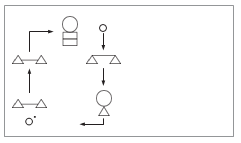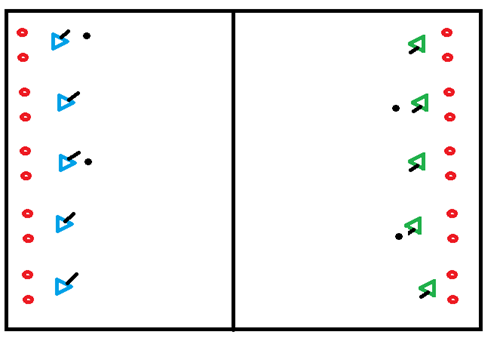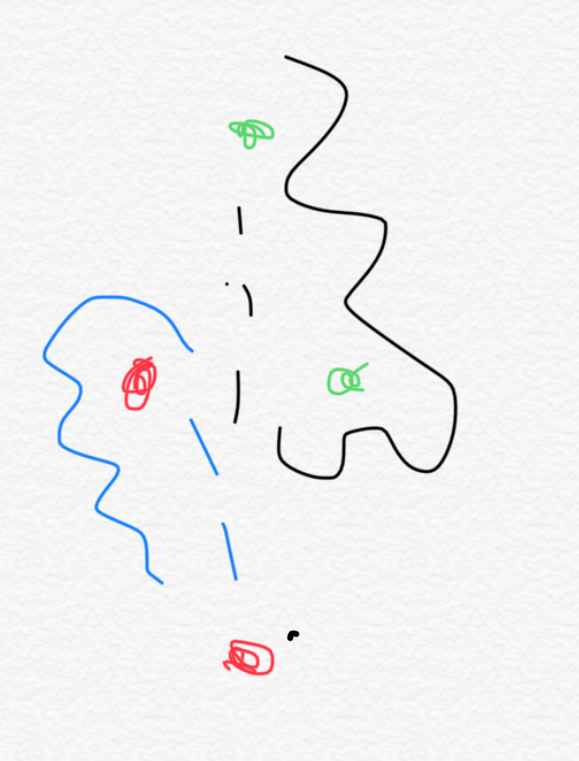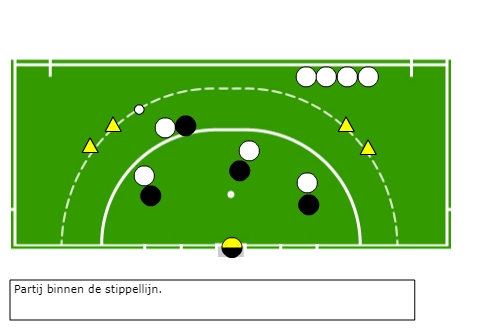Hockey drills
- 30 sec jumping jacks ( cfr army)
- 30 sec sit ups
- 30 sec squats
- 30 sec push-ups and arm twists
- 30 sezc high knee running in place
- 30 sec lunges
- With the different materials you can make nice courses.
- A course is a fun and fast way to get the children to repeat their skills.
- It is also possible to make courses with a certain theme.
- Possible themes are: drifting, slalom, passing, playing high, making tempo.
- The arrows and traffic signs can be used in all sorts of exercises in a course and in relays.
- Here are some examples of possible courses

- The catcher must try to catch the others.
- When you are tagged, you stand with your legs apart and your arms crossed.
- Without the ticker knowing, the group has appointed a secret saviour;
- He may redeem the ticked by secretly tapping them.
- The game stops when the secret deliverer is caught.

Goal: Build up by moving the ball.
Instruction:
- 1 starts with the ball and plays it to 2
- 2 plays the ball back to 1
- 1 plays the ball to 3
- 3 plays the ball to 4
- 4 starts the attack and may choose how he does this
Point of attention: The defenders try to get rid of the ball as quickly and skillfully as possible
- sprint within 30s (adjust time if necessary to level)
- back line-->23
- 23-->back line
- back line-->23
- 23-->back line
- back line-->23
- 23-->back line
- 2 equal teams, or in case of odd numbers with a joker,
- try to keep the players on the team for as long as possible.
- This can be done through short replay, the duel and then replay.
- Two teams with substitutes, substitutions are made when a goal is scored.
- Each person defends a goal, on each field there are 5 goals,
- so there are also 5 people who defend these goals.
- If a goal is scored in your goal, you have to sit on the sidelines and you become a substitute.
- A new player (substitute) from the side enters the field and will defend the goal.
- If a goal is scored, it is 1 point.
- The team that has the most points at the end of the game is the winner.


- Someone runs in from the red, takes the ball in the run and runs away strongly,
- he/she plays it to the other person who is standing near red.
- Green comes running in, takes the ball in the run and turns away strongly, playing to the other person who is standing near green.
- 2 pawns face each other,
- at a random distance (depends on whether you want to push or flatten, for example).
- Player 1 and 3 stand with pawn A.
- Player 2 stands at pawn B.
- 1 plays the ball to player 2,
- 2 receives the ball.
- After player 1 passes the ball, he runs after his ball towards pion B.
- When player 2 has passed again he runs in the direction of pion A.
- etc. etcde
- You can play this exercise with minimum 3 players, maximum 5 otherwise the intensity will be very low.
Overplaying to score
- Two players continuously play the ball over
- until one of them is so close to the goal
- that he can score in the goal.
Variation 2-1 situation:
- Under pressure from the defender, the attackers must now play together and try to score.
- The defender can score a point by conquering the ball and then dribbling over the dead ball line.
- This is the short side without a goal.
Goal
:As an attack is to get the most out of your attackAs a
defense is to defend smartly.
Set-up:
- The field is up to the dotted line.
- The attackers take the ball from somewhere on the dotted line and must try to score.
- The defenders must try to defend the ball from the outside.
- The attackers score 3 points when they score; 2 points when they force a corner and 1 point when they have a good scoring chance.
- The defenders get 3 points when they defend the ball by playing in between the pawns; 2 points when they get a free hit and 1 point when they manage to play the ball over the touchline.
NB When defenders score, the ball does not have to be run between the pawns or accepted behind the pawns.

Variations:
- Adjust the size of those teams according to the amount of players available. You can also have one team on the sidelines and play a 2 to 3 minute game each time. That way there is a break and the players have time to discuss and analyse.
- The scoring pawns for the defenders can also be made smaller.
- You can play with a 'chameleon' and thus give the attackers an overtal when scoring is not going well.
Points of attention:
- Make sure it is clear who is picking up which man.
- As defenders, try to keep a low profile and prevent fouls.
- As the attackers, try to actively look for a foot.
- Look for opportunities to double-team When you, as the defender, realise that your man is not being active enough in the attack, help your buddy defend and push the attacker into a corner
- As the attacker, look for the backhand of your opponent. A right-wing attack is therefore often easier to execute than the other way around
- divide the team by 2 and run it.
- Sit on top and blow the whistle on any fouls called
- so they get used to it.








